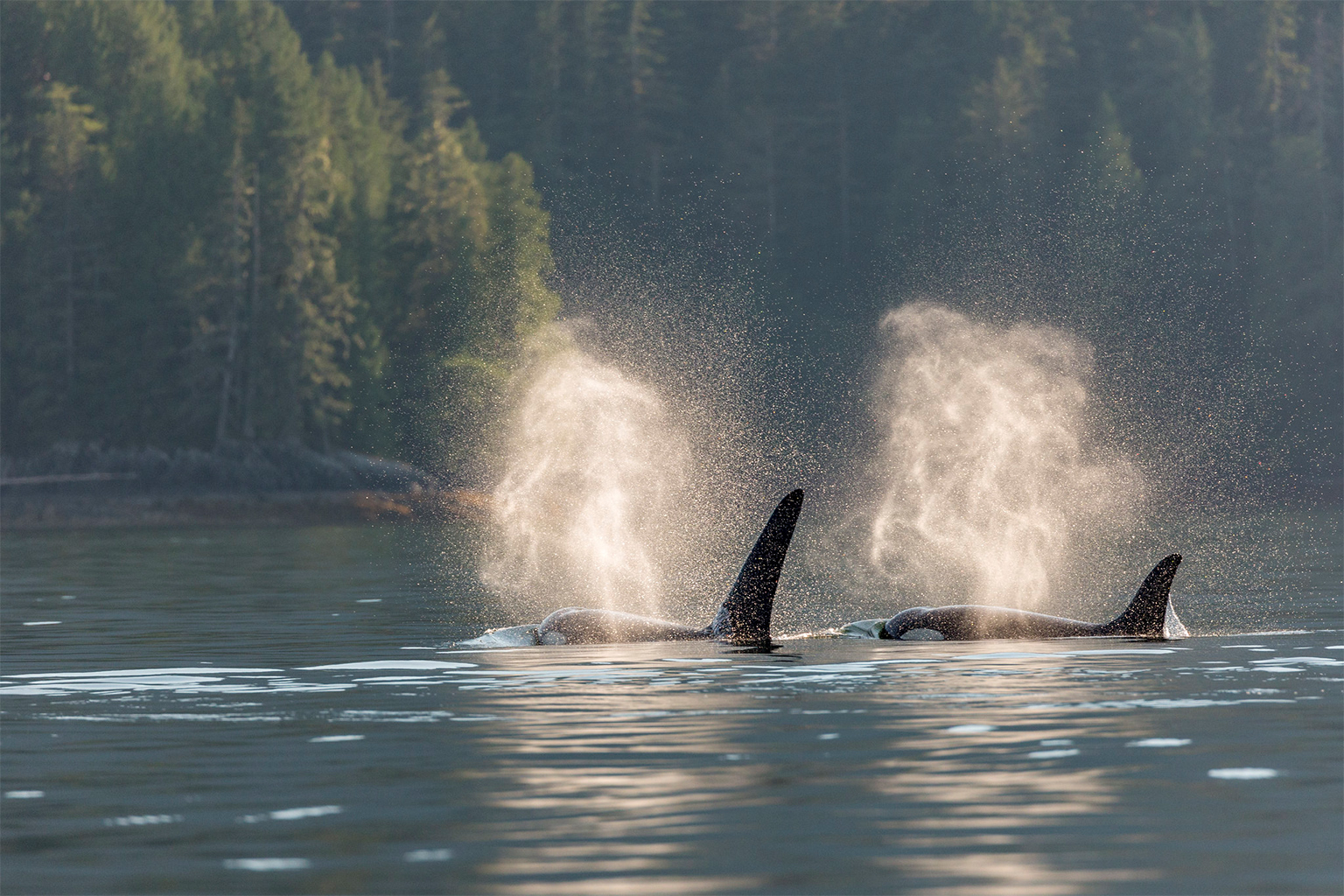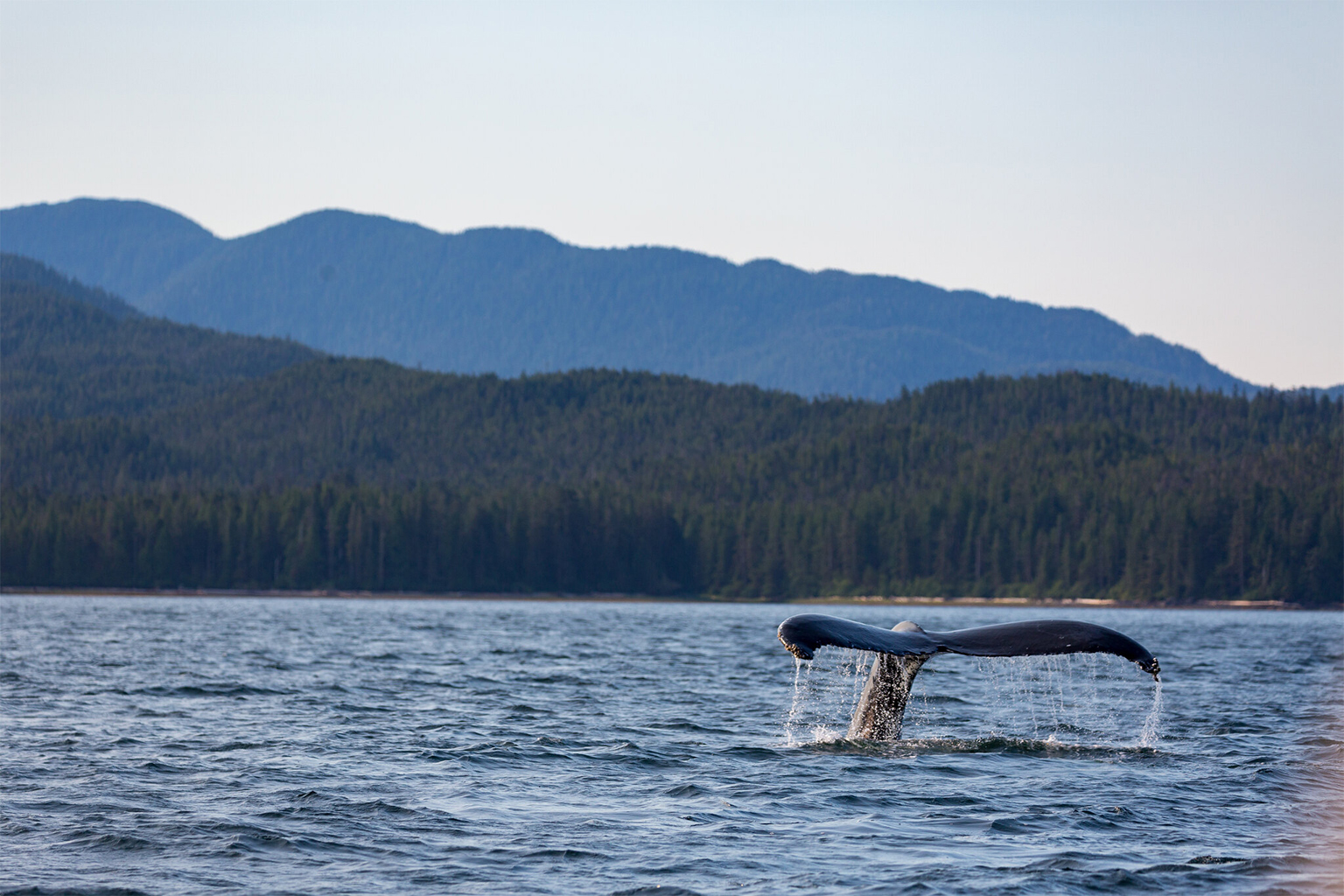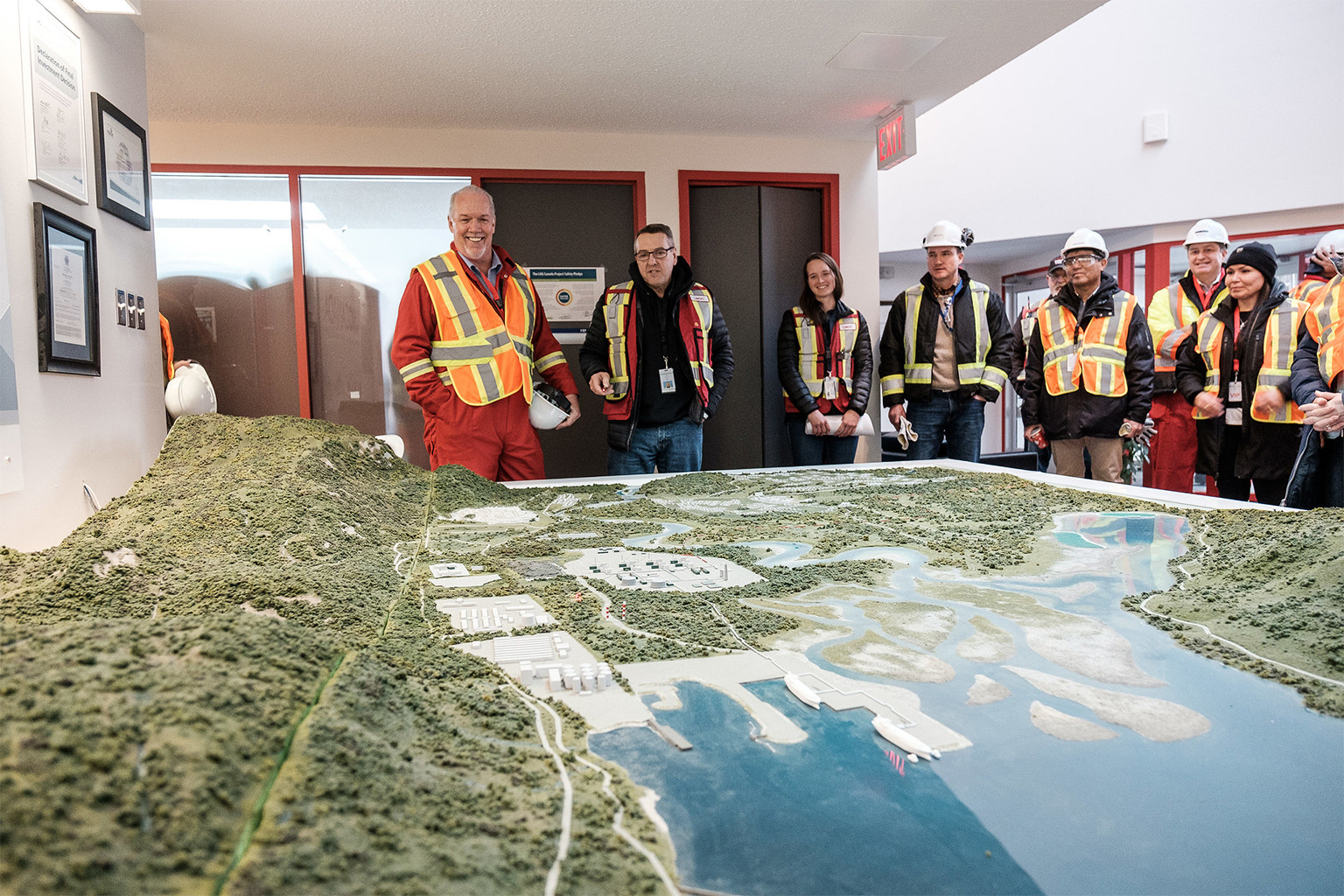- The nutrient-rich ancestral waters of the Gitga’at First Nation in northern British Columbia are a critical habitat for fin, humpback and killer whales.
- The development of a $35.5 billion LNG terminal threatens these whales, as shipping traffic in the region is projected to surge, leading to more frequent encounters between whales and ships, a recent study warns.
- It uses whale movement data and predicted ship traffic modeling to conclude that two fin whales and 18 humpback whales could be killed each year in ship strikes in Gitga’at territorial waters.
- Researchers suggest mitigation measures like reducing ship speeds in whale hotspots and restricting ship traffic during August, when whales are most abundant in these waters.
In September 2022, researchers at BC Whales, a Canadian research nonprofit studying cetaceans in the north of British Columbia province, gasped when they saw a drone image of a humpback whale known as Moon. Each summer, she regularly visited the many meandering waterways in the region with her calves, along with hundreds of other humpbacks, feeding in the food-rich, tranquil waters. But this time, she looked different.
Moon’s spine was crooked and her back half was paralyzed, probably after being hit by a ship, BC Whales researchers concluded. Despite heroically swimming thousands of kilometers to Hawai‘i propelled by only her pectoral fins, she likely died emaciated and eaten by parasites within months — a fate met by many whales hit by ships.
“Ship strikes can kill or injure whales, and injuries can eventually lead to death, either through infection or reduced mobility, which eventually leads to starvation,” said Eric Keen, science director at BC Whales. He called Moon’s case a “fate worse than death.”
As more ships cruise the waterways in northern British Columbia, mostly passenger cruise liners and freight carriers sailing to expanding ports in Prince Rupert and Kitimat, many cetaceans on the route are likely to meet Moon’s destiny, according to a recent study led by Keen.
The biggest cause of concern in the next decade is the liquefied natural gas terminal at Kitimat, being built as part of one of the largest, and very popular, energy investments in Canadian history. The LNG Canada project is jointly owned by Royal Dutch Shell, Malaysia’s Petronas, PetroChina, Mitsubishi Corporation, and Korea Gas Corporation.

The study, published in the journal Endangered Species Research, predicts that by 2030, two fin whales (Balaenoptera physalus) and 18 humpback whales (Megaptera novaeangliae) may die annually from ship strikes in the territorial waters of the Gitga’at First Nation and its surrounding waterways in northern BC. Those numbers amount to a twofold and fourfold spike, respectively, in whale deaths compared to today. The researchers predict most of these deaths to occur during August, when many whales congregate in the region during their migration.
The waterways in this region have been a critical habitat for fin , humpback and killer whales (Orcinus orca) for millennia. However, commercial whaling operations in the 1900s decimated their numbers, which only began recovering in the early 2000s.
Surveys estimate that more than 450 humpback whales and over 120 fin whales frequent these waterways today. About three-fourths of the humpback whales and 70% of fin whales return here from their tropical breeding grounds each year. In Canada, fin whales are considered a threatened species, and humpback whales are of special concern.
In recent decades, as whale numbers begin to recover worldwide following the end of commercial whaling, the rise in global shipping traffic has made ship strikes the biggest threat to whale populations.
“It’s probably the dominant, human-related cause of death [for large whales],” says cetacean biologist John Calambokidis at Cascadia Research Collective in the U.S. state of Washington. Fishing gear entanglements and underwater noise are other threats.

More ships, more strike risk
The researchers analyzed present-day vessel traffic in Gitga’at territorial waters using a vessel information database, and simulated the possible vessel traffic after the LNG terminal in the port town of Kitimat becomes operational in 2030.
The C$48 billion ($35.5 billion) project aims to export 26 million metric tons of LNG per year once at full operating capacity, from the controversial Coastal GasLink pipeline mainly to Asian markets. The Gitga’at Nation will receive an initial funding of C$1.5 million ($1.11 million from the province and more than C$500,000 ($370,000) yearly thereafter. LNG Canada has promised around 7,500 local jobs, sparking approval from the First Nation, which cites economic gains to the Indigenous community’s poverty alleviation and social welfare efforts.
The project also comes with a massive carbon cost: about 4 million metric tons of CO2 emissions each year, for at least 25 years.
The researchers then juxtaposed the vessel traffic data with data on the density of whales seen in the region and their seasonal abundance. This latter data set comes from meticulous surveys by Gitga’at environmental guardians as part of the Ships, Whales and Acoustics in Gitga’at Territory (SWAG) project, a collaboration between BC Whales, the Gitga’at Nation and WWF Canada. They then built a model to predict how many times a ship would come close to a whale, and how often the encounter would end in a whale strike.
The analysis found that the biggest death risk for fin whales and humpback whales would come from the 200 to 400 large LNG carrier ships expected to visit the terminal each year, transiting twice as often through the waterways, with each ship escorted by a tugboat.
“Our models predict that once LNG projects go live in Gitga’at waters, whales will be struck and killed at such a high rate that both species’ populations will begin to decline along the entire BC coast,” Keen said. “But strikes from the menagerie of other commercial and recreational vessels transiting Gitga’at waters will become a serious issue too.”
The study is the first of its kind in the region to put some numbers on the ambiguous and often underreported issue of ship strikes in Canada’s Pacific waters. The risk to cetaceans is already evident: within a span of 10 days in July, there were three reports of ship strikes reported in Gitga’at waters from passenger and cargo ships, all involving humpback whales.
“What I think is a little different about this study and makes it valuable is [that] it’s being conducted ahead of an increase in vessel traffic,” said Calambokidis, who was not involved in the study. “It has taken a very proactive approach.”

Slowdown zones
The Gitga’at Nation, which supports the LNG project, said it’s also worried about the projected increase in the deaths of whales, a culturally revered and economically vital animal, in its territory.
“Gitga’at has been working with the shipping industry and managers on shipping guidelines to foster greater waterway safety in our territory,” the nation said in a statement. “We will continue that work to encourage and insist on implementing measures that better protect whales.”
The researchers of the study modeled different scenarios to mitigate the impact of ship strikes on whales. They found that reducing the speed of all large ships to 10 knots (18.5 kilometers per hour) or slower in whale hotspots would be effective in reducing whale deaths. Janie Wray, the CEO of BC Whales and a co-author of the study, called for a “slowdown zone” around critical whale hotspots in the region. Slower ships also reduce emissions and underwater noise that disrupt whale sensory abilities to navigate. In 2020, Canada announced mandatory speed restriction for ships on the Gulf of St. Lawrence to 10 knots to protect the critically endangered North Atlantic right whales (Eubalaena glacialis) on its east coast.
Studies have shown that ships cruising at speeds faster than 12 knots (22.2 km/h) are likely to kill whales, and those faster than 18 knots (33.3 km/h) are almost certain to result in whale deaths in the event of a strike. However, under current regulations, slowing down is voluntary in most whale habitats, with a survey by Oceana Canada finding about two-thirds of vessels don’t comply.
“There is a limit to how slow the large tankers can safely go,” Keen said, pointing to scrubber water, which has toxic chemicals, that is discharged the longer the ships stay in the water. “So we cannot put all our hopes [on] speed restrictions.”

The best mitigation step, the study found, would be to restrict LNG traffic during August, when whales are most abundant in Gitga’at waters.
The findings could provide decision-makers and stewardship managers with concrete numbers on the risks of ship strikes as vessel traffic increases, which can then be weighed against social and financial costs.
“If the authorities are concerned about the levels of mortality predicted in this study, it would be prudent and wise to pause the shipping projects until substantial action plans can be developed,” Keen said.
Transport Canada, the federal agency responsible for implementing speed regulations, said that when LNG Canada becomes operational, it will add 350 vessels to the existing traffic. While a spokesperson for the agency said that LNG Canada is committed to protecting the environment in which they operate, they didn’t identify whether any mandatory speed restrictions were being put in place or if they planned to address the concerns raised in the study.
Whether through voluntary or mandatory measures, the government and industry must act now to show their actions are effective in conserving whales, said Hussein Alidina from WWF Canada, another co-author of the study.
“Nobody wants to see a dead whale on their bow,” he said. “It’s in nobody’s interest.”
Banner image of a humpback whale by Fernando Flores via Flickr (CC BY-SA 2.0).
Related listening from Mongabay’s podcast: New whale calls and dolphin behaviors discovered with bioacoustics. Listen here:
New ecolabel will certify ‘Whale-Safe’ shipping companies and cruise lines
Citations:
Keen, E. M., Wray, J., Meuter, H., Thompson, K.-L., Barlow, J. P., & Picard, C. R. (2017). ‘Whale wave’: Shifting strategies structure the complex use of critical fjord habitat by humpbacks. Marine Ecology Progress Series, 567, 211-233. doi:10.3354/meps12012
Keen, E. M., O’Mahony, É., Nichol, L. M., Wright, B. M., Shine, C., Hendricks, B., … Wray, J. (2023). Ship-strike forecast and mitigation for whales in Gitga’at First Nation territory. Endangered Species Research, 51, 31-58. doi:10.3354/esr01244
Keen, E. M., Pilkington, J., O’Mahony, É., Thompson, K.-L., Hendricks, B., Robinson, N., … Wray, J. (2021). Fin whales of the Great Bear Rainforest: Balaenoptera physalus velifera in a Canadian Pacific fjord system. PLOS ONE, 16(9), e0256815. doi:10.1371/journal.pone.0256815
Vanderlaan, A. S. M., & Taggart, C. T. (2007). Vessel collisions with whales: The probability of lethal injury based on vessel speed. Marine Mammal Science, 23(1), 144-156. doi:10.1111/j.1748-7692.2006.00098.x
FEEDBACK: Use this form to send a message to the author of this post. If you want to post a public comment, you can do that at the bottom of the page.
Update: This article was updated on August 25, 2023, with a response by LNG Canada.
